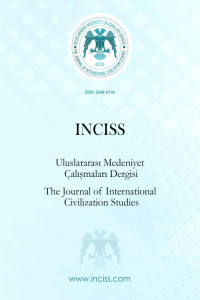Abstract
İslam’ın irfanî bir yorumu olan tasavvuf sûfilerin manevi boyutta yaşayıp deneyimledikleri bir alemin verilerini mecaza dayalı bir şiir diliyle ifade etmiştir. Mecaza dayalı bu irfanî dil Arap, Fars ve Türk edebiyatlarında özel bir edebi anlayış olarak süreç içerisinde gelişim göstermiştir. Türk edebiyatındaki mutasavvıf şairler de edebi ürünlerinde bu dil mirasını kendi zevk ve meşreplerine uygun olarak kullanmışlardır. Bu şairlerden birisi olan Şeyh Galip özgün tasavvufî sembol ve mecazlarla yürüyen bir eser olan Hüsn ü Aşk’ı kaleme almıştır. Eserin kurgusunda yer alan temel ögelerin -kişi ve yer adlarının- neredeyse tamamı tasavvufî birer semboldür. Bununla birlikte daha spesifik bir yaklaşımla metne baktığımızda en küçük ayrıntılarda dahi sembolik bir dilin gizli olduğunu ve bu dilin metnin kurgusal yapısına hizmet ettiğini görürüz. Öyle ki Hüsn’ün Aşk’a hediyesi olan ‘at’ ve ‘kılıç’ eserde, maddî alemde temsil ettikleri bağlamlar dışında ele alınmıştır. Her iki kavram, tasavvufî bağlamda ele alındıklarında bunların birer sembol olduğu ve bu sembollerin hakîkî yani ilâhî aleme ilişkin manalar taşıdıkları görülür. Bu çalışmada seyr ü sülûkun olmazsa olmaz iki öğretisi olan irade ve gayret unsurları eserdeki kılıç ve at alegorileri üzerinden gösterilmeye çalışılmıştır. Çalışma sonucunda divan şiirine sıklıkla konu olan ‘at’ ve ‘kılıç’ motiflerinin Hüsn ü Aşk’ta tasavvufî bağlamda birer sembol olduğu sonucuna ulaşılmıştır.
Keywords
References
- Bilgin, O. (1995). Türk kültüründe at ve çağdaş atçılık. İstanbul: TJK Yayınları.
- Bozkurt, N. (2002). Kılıç. TDV İslam ansiklopedisi içinde. (Cilt. 25, ss. 405- 407). Ankara: TDV Yayınları.
- Devellioğlu, F. (2002). Osmanlıca-Türkçe ansiklopedik lûgat. Ankara: Aydın Kitabevi.
- Doğan, M. N. (2008). Şeyh Galib: Hüsn ü Aşk (Metin, düz yazıya çeviri notlar ve açıklamalar). İstanbul: Yelkenli Yayınevi.
- Erginli, Z. (2006). Tasavvuf terimleri sözlüğü. İstanbul: Kalem Yayınevi.
- Mermer, A. ve N. Koç Keskin (2005). Eski Türk edebiyatı terimleri sözlüğü. Ankara: Akçağ Yayınları.
- Naskali, E. (1995). Türk kültüründe at ve çağdaş atçılık. İstanbul: Resim Matbaacılık.
- Okuyucu, C. (2013). Divan edebiyatı estetiği. İstanbul: Kapı Yayınları.
- Öz, M. (2013). Zülfikar. TDV İslam ansiklopedisi içinde. (Cilt. 44, ss. 553- 554). İstanbul: TDV Yayınları.
- Pala, İ. (2014). Ansiklopedik Divân şiiri sözlüğü. İstanbul: Kapı Yayınları.
- Serinsu, A. N. Dini terimler sözlüğü. Ankara: Millî Eğitim Bakanlığı Yayınları.
- Şeyh, G. (2006). Şeyh Galip- Hüsn ü Aşk (Çev: A. Gölpınarlı). İstanbul: Türkiye İş Bankası Kültür Yayınları.
- Yılmaz, H. (1995). Seyr u Sülûk- tasavvufî eğitim. Altınoluk Dergisi, 112, 32.
Abstract
Sufism, which is a mystic interpretation of Islam, has expressed the data of a realm that sufis live and experience in the spiritual dimension in a poetic language based on metaphor. This mystical language based on metaphor has developed in the process as a special literary understanding in Arabic, Persian and Turkish literatures. Sufi poets in Turkish literature have also used this language heritage in their literary products in accordance with their tastes and traditions. One of these poets, Şeyh Galip, has written Hüsn ü Aşk, a work that walks with original sufi symbols and metaphors. Almost all of the basic elements contained in the fiction of the work-the names of people and places- are sufi symbols. However, when we look at the text with a more specific approach, we see that the symbolic language is hidden even in the smallest details and that this language serves the fictional structure of the text. For instance the ‘horse’ and ‘sword’, which are Husn's gift to Aşk, are present in the work outside the contexts they represent in the material world. When both concepts are considered in a sufi context, it is seen that these concepts are symbols and that these symbols carry meanings from the genuine, divine realm. In this study, the elements of will and effort, which are the two indispensable teachings of seyr ü süluk, were tried to be shown through the metaphors of sword and horse in the work. As a result of the study, it has been seen that the concepts of ‘horse’ and ‘sword’, which are often the subject of divan poetry, are actually symbols in the context of Sufism in Hüsn ü Aşk.
Keywords
References
- Bilgin, O. (1995). Türk kültüründe at ve çağdaş atçılık. İstanbul: TJK Yayınları.
- Bozkurt, N. (2002). Kılıç. TDV İslam ansiklopedisi içinde. (Cilt. 25, ss. 405- 407). Ankara: TDV Yayınları.
- Devellioğlu, F. (2002). Osmanlıca-Türkçe ansiklopedik lûgat. Ankara: Aydın Kitabevi.
- Doğan, M. N. (2008). Şeyh Galib: Hüsn ü Aşk (Metin, düz yazıya çeviri notlar ve açıklamalar). İstanbul: Yelkenli Yayınevi.
- Erginli, Z. (2006). Tasavvuf terimleri sözlüğü. İstanbul: Kalem Yayınevi.
- Mermer, A. ve N. Koç Keskin (2005). Eski Türk edebiyatı terimleri sözlüğü. Ankara: Akçağ Yayınları.
- Naskali, E. (1995). Türk kültüründe at ve çağdaş atçılık. İstanbul: Resim Matbaacılık.
- Okuyucu, C. (2013). Divan edebiyatı estetiği. İstanbul: Kapı Yayınları.
- Öz, M. (2013). Zülfikar. TDV İslam ansiklopedisi içinde. (Cilt. 44, ss. 553- 554). İstanbul: TDV Yayınları.
- Pala, İ. (2014). Ansiklopedik Divân şiiri sözlüğü. İstanbul: Kapı Yayınları.
- Serinsu, A. N. Dini terimler sözlüğü. Ankara: Millî Eğitim Bakanlığı Yayınları.
- Şeyh, G. (2006). Şeyh Galip- Hüsn ü Aşk (Çev: A. Gölpınarlı). İstanbul: Türkiye İş Bankası Kültür Yayınları.
- Yılmaz, H. (1995). Seyr u Sülûk- tasavvufî eğitim. Altınoluk Dergisi, 112, 32.
Details
| Primary Language | Turkish |
|---|---|
| Subjects | Classical Turkish Literature of Ottoman Field |
| Journal Section | Research Article |
| Authors | |
| Publication Date | June 4, 2025 |
| Submission Date | November 8, 2023 |
| Acceptance Date | December 23, 2023 |
| Published in Issue | Year 2025 Volume: 10 Issue: 1 |


